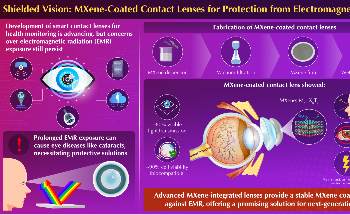
According to a study published in Small Science on June 4, 2025, researchers at Waseda University have developed MXene-coated contact lenses that protect the eyes from electromagnetic radiation while maintaining hydration and optical clarity.
As smart contact lenses become more common, concerns about radiation exposure and its potential impact on eye health are increasing. These risks include conditions such as cataracts and other ocular diseases. The development of MXene-coated lenses offers a potential path toward safer wearable eye technologies.
The rise of the Internet of Things and wireless devices has led to greater interest in their long-term health effects. In particular, prolonged exposure to electromagnetic radiation (EMR) is a growing concern. MXenes, a class of two-dimensional transition metal carbides and nitrides, have shown promise as materials for EMR shielding. However, their tendency to oxidize and poor adhesion have limited their practical use.
In this study, a team led by Professor Takeo Miyake from Waseda University’s Graduate School of Information Production and Systems in Japan developed MXene-coated contact lenses with stable optical and EMR-shielding properties. The team’s fabrication method improves the adhesion of the MXene layer and reduces oxidation, addressing key technical challenges.
The research was a collaborative effort between Waseda University, Kyoto University, and Yamaguchi University Hospital. The project combined expertise in ophthalmology, 2D materials, and nanofabrication to ensure eye safety.
Coauthors of the study include Professor Kazuhiro Kimura and Assistant Professor Atsushige Ashimori from Yamaguchi University Hospital, Associate Professor Jun Hirotani from Kyoto University, Dr. Lunjie Hu from Waseda University, and Assistant Professor Saman Azhari, also from Waseda University.
Smart contact lenses with built-in electronic components are getting a lot of attention as the next big thing in wearable devices. For the first time, though, this means we’ll be placing wireless circuit lenses directly on our corneas, exposing them to electromagnetic waves around the clock. Inspired by breakthroughs in 2D materials and device fabrication technologies, we came up with highly functional protective contact lenses.
Takeo Miyake, Study Lead Author and Professor, Waseda University
The research team began by creating MXene dispersions. These were vacuum filtered using mixed cellulose ester (MCE) membranes to form MXene-based films. A wet transfer method using acetone was then applied to transfer the films onto commercial soft contact lenses.
The team then evaluated the physical properties, conductivity, and safety of the resulting lenses.
“We opted for a wet-transfer method because it allows for the easy attachment of MXene nanosheets to the unusually shaped surface of soft contact lenses, ensuring scalability,” explained Professor Miyake.
The lenses showed over 80 % transmission of visible light, maintained conductivity, reduced dehydration, and demonstrated good biocompatibility, with more than 90 % cell viability.
The thickness of the MXene layers varied based on the concentration of the dispersions. The dissolved MCE membrane improved MXene adhesion and also helped prevent oxidation of the material.
Prof. Miyake discusses the significance of their method, saying, “Our research can have a multifaceted impact. First, the stable and effortless coating of MXene nanosheets via wet transfer broadens the possibilities for commercial applications. Secondly, our method is simple yet effective in preventing MXene oxidation, turning a commonly overlooked challenge—MXene oxidation—into a resolved obstacle.”
MXene-coated lenses were tested on porcine eyes to evaluate their electromagnetic shielding performance. The eyes were exposed to microwave heating and thermal imaging. The lenses showed a rapid temperature increase, indicating effective absorption and dissipation of electromagnetic radiation. This helped prevent direct heating of the eye tissue. Under high-frequency microwave exposure, the MXene material absorbed electromagnetic energy and released it as thermal radiation, providing a shielding effect.
The researchers reported an electromagnetic shielding effectiveness of up to 93 %, the highest known value for biocompatible materials of comparable thickness. The lenses offered significant protection against high-frequency radiation.
These results suggest that the MXene-coated lenses are a promising option for safer wearable technologies. They combine electromagnetic shielding with comfort and usability, due to the properties of MXene nanosheets.
In addition to eye protection, this work may support the broader use of nanomaterials in smart wearables, medical implants, and bioelectronics, where both safety and functionality are important.
Journal Reference:
Hu, L., et al. (2025) MXene-Integrated Contact Lens: A Breakthrough in Wearable Eye Protection and Healthcare. Small Science. doi.org/10.1002/smsc.202400628
